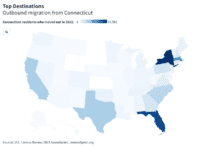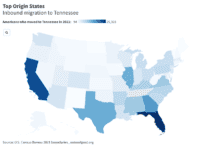
As the COVID-19 pandemic spread, many Americans struggled to make ends meet without a weekly paycheck after the mass layoffs in the early days of the pandemic. Although expanded unemployment benefits helped for a while, households still had to pay for goods and other expenses with less money. Many, then, turned to credit cards to make up the difference between rising living costs and less income.
Credit card balances collectively reached $856 billion as of the fourth quarter of 2021, a $52 billion increase from $804 billion in the third quarter, the Federal Reserve Bank of New York reports. Despite the increase, the federal reserve bank notes, credit card balances are $71 billion lower than at the end of 2019. (Here are the states where debt is increasing the most during COVID-19.)
Including both bank and retail plastic, credit card debt averaged $6,569 per cardholder with unpaid balances in the fourth quarter of 2020, according to 2022 Credit Card Debt Statistics from Lending Tree. And just like housing costs and gas prices, credit card debt varies by state.
To determine the states with the most credit card debt, 24/7 Wall St. reviewed Lending Tree’s report. States were ranked on the average credit card debt per cardholder, using credit report data from 2021.
New Jerseyans shouldered the most credit card debt at an average of $7,872 per cardholder. But other Northeast and Mid-Atlantic states have residents with high unpaid balances, too. Connecticut came in at No. 2 with average debt per cardholder of $7,721, and average debt in No. 3 Maryland is $7,464.
Meanwhile, Kentuckians are living comparatively debt-free with an average unpaid credit card balance of $5,441 – nearly $2,500 less than New Jersey cardholders. The disparity could be attributed to the higher cost of living in the Garden State. According to a 24/7 Wall St. study, the cost of living in New Jersey is 15% higher than the average nationwide, while the cost of living in Kentucky is 7% less than average. (Here are the most expensive states to live in.)
Click here to see the States with the most credit card debt

50. Kentucky
> Avg. credit card debt: $5,441
> Median household income: $52,295 (7th lowest)
[in-text-ad]

49. Mississippi
> Avg. credit card debt: $5,539
> Median household income: $45,792 (the lowest)

48. Arkansas
> Avg. credit card debt: $5,601
> Median household income: $48,952 (3rd lowest)

47. Indiana
> Avg. credit card debt: $5,674
> Median household income: $57,603 (14th lowest)
[in-text-ad-2]

46. Michigan
> Avg. credit card debt: $5,788
> Median household income: $59,584 (19th lowest)

45. Ohio
> Avg. credit card debt: $5,792
> Median household income: $58,642 (15th lowest)
[in-text-ad]

44. Montana
> Avg. credit card debt: $5,836
> Median household income: $57,153 (11th lowest)

43. West Virginia
> Avg. credit card debt: $5,928
> Median household income: $48,850 (2nd lowest)

42. Iowa
> Avg. credit card debt: $5,939
> Median household income: $61,691 (21st lowest)
[in-text-ad-2]

41. Louisiana
> Avg. credit card debt: $5,956
> Median household income: $51,073 (4th lowest)

40. New Mexico
> Avg. credit card debt: $5,972
> Median household income: $51,945 (6th lowest)
[in-text-ad]

39. Idaho
> Avg. credit card debt: $5,978
> Median household income: $60,999 (20th lowest)

38. Oregon
> Avg. credit card debt: $5,994
> Median household income: $67,058 (18th highest)

37. Alabama
> Avg. credit card debt: $6,005
> Median household income: $51,734 (5th lowest)
[in-text-ad-2]

35. Wisconsin
> Avg. credit card debt: $6,008
> Median household income: $64,168 (21st highest)

35. South Dakota
> Avg. credit card debt: $6,008
> Median household income: $59,533 (18th lowest)
[in-text-ad]

34. Tennessee
> Avg. credit card debt: $6,048
> Median household income: $56,071 (9th lowest)

33. Missouri
> Avg. credit card debt: $6,097
> Median household income: $57,409 (13th lowest)

32. Maine
> Avg. credit card debt: $6,173
> Median household income: $58,924 (16th lowest)
[in-text-ad-2]

31. Kansas
> Avg. credit card debt: $6,184
> Median household income: $62,087 (24th lowest)

30. Arizona
> Avg. credit card debt: $6,195
> Median household income: $62,055 (23rd lowest)
[in-text-ad]

29. Wyoming
> Avg. credit card debt: $6,204
> Median household income: $65,003 (19th highest)

28. Oklahoma
> Avg. credit card debt: $6,207
> Median household income: $54,449 (8th lowest)

27. North Carolina
> Avg. credit card debt: $6,209
> Median household income: $57,341 (12th lowest)
[in-text-ad-2]

26. Minnesota
> Avg. credit card debt: $6,223
> Median household income: $74,593 (13th highest)

25. Illinois
> Avg. credit card debt: $6,228
> Median household income: $69,187 (17th highest)
[in-text-ad]

24. Utah
> Avg. credit card debt: $6,279
> Median household income: $75,780 (11th highest)

23. Nebraska
> Avg. credit card debt: $6,401
> Median household income: $63,229 (25th highest)

22. South Carolina
> Avg. credit card debt: $6,442
> Median household income: $56,227 (10th lowest)
[in-text-ad-2]

21. Washington
> Avg. credit card debt: $6,480
> Median household income: $78,687 (7th highest)

20. Vermont
> Avg. credit card debt: $6,525
> Median household income: $63,001 (25th lowest)
[in-text-ad]

19. Pennsylvania
> Avg. credit card debt: $6,527
> Median household income: $63,463 (23rd highest)

18. North Dakota
> Avg. credit card debt: $6,588
> Median household income: $64,577 (20th highest)

17. Nevada
> Avg. credit card debt: $6,592
> Median household income: $63,276 (24th highest)
[in-text-ad-2]

16. Georgia
> Avg. credit card debt: $6,604
> Median household income: $61,980 (22nd lowest)

15. New Hampshire
> Avg. credit card debt: $6,661
> Median household income: $77,933 (8th highest)
[in-text-ad]

14. California
> Avg. credit card debt: $6,729
> Median household income: $80,440 (5th highest)

13. Delaware
> Avg. credit card debt: $6,736
> Median household income: $70,176 (16th highest)

12. Rhode Island
> Avg. credit card debt: $6,759
> Median household income: $71,169 (15th highest)
[in-text-ad-2]

11. Colorado
> Avg. credit card debt: $6,762
> Median household income: $77,127 (9th highest)

10. Massachusetts
> Avg. credit card debt: $6,942
> Median household income: $85,843 (2nd highest)
[in-text-ad]

9. New York
> Avg. credit card debt: $6,973
> Median household income: $72,108 (14th highest)

8. Texas
> Avg. credit card debt: $6,999
> Median household income: $64,034 (22nd highest)

7. Florida
> Avg. credit card debt: $7,049
> Median household income: $59,227 (17th lowest)
[in-text-ad-2]

6. Alaska
> Avg. credit card debt: $7,127
> Median household income: $75,463 (12th highest)

5. Hawaii
> Avg. credit card debt: $7,246
> Median household income: $83,102 (4th highest)
[in-text-ad]

4. Virginia
> Avg. credit card debt: $7,442
> Median household income: $76,456 (10th highest)

3. Maryland
> Avg. credit card debt: $7,464
> Median household income: $86,738 (the highest)

2. Connecticut
> Avg. credit card debt: $7,721
> Median household income: $78,833 (6th highest)
[in-text-ad-2]

1. New Jersey
> Avg. credit card debt: $7,872
> Median household income: $85,751 (3rd highest)
Are You Still Paying With a Debit Card?
The average American spends $17,274 on debit cards a year, and it’s a HUGE mistake. First, debit cards don’t have the same fraud protections as credit cards. Once your money is gone, it’s gone. But more importantly you can actually get something back from this spending every time you swipe.
Issuers are handing out wild bonuses right now. With some you can earn up to 5% back on every purchase. That’s like getting a 5% discount on everything you buy!
Our top pick is kind of hard to imagine. Not only does it pay up to 5% back, it also includes a $200 cash back reward in the first six months, a 0% intro APR, and…. $0 annual fee. It’s quite literally free money for any one that uses a card regularly. Click here to learn more!
Flywheel Publishing has partnered with CardRatings to provide coverage of credit card products. Flywheel Publishing and CardRatings may receive a commission from card issuers.
Thank you for reading! Have some feedback for us?
Contact the 24/7 Wall St. editorial team.
 24/7 Wall St.
24/7 Wall St. 24/7 Wall St.
24/7 Wall St.


